Search results for: 'fibula'
-
 Roman fibula
Roman fibulaAncient roman fibula of the kraeftig profilierte fibula type. The piece is a beautiful example of this common type of fibulae during roman imperial times.
Price: on request Celtic fibula
Celtic fibulaRare fibula from the La Tène culture with beautiful enamel inlays. The main material is well preserved for an iron fibula.
Price: on request Rare frog fibula
Rare frog fibulaZoomorphic fibula dating to the Roman Principate. Very nice enameled work. Rare variant of this popular fibula type from Roman Gaul.
Price: on request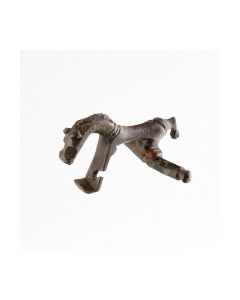 Roman horse fibula
Roman horse fibulaSkillfull bronze fibula in horse shape. The type was used in Central Europe during the later Principate.
Price: on request Roman Kraeftig Profilierte fibula
Roman Kraeftig Profilierte fibulaFibula with noble green patina. An import from mainland Europe to Roman Britain. From the 1st century AD. Published in two stardard works on ancient brooches by Richard Hattatt.
Price: on request Roman bronze fibula
Roman bronze fibulaBrooch from the earlier Roman imperial period with a nice patina. This type of brooch was common in Central and Northern Europe. This very piece is from the Roman city of Novaesium, today's Neuss in Germany.
Price: on request Gallo-Roman animal fibula
Gallo-Roman animal fibulaZoomorphe Fibel mit Wildtier als Motiv. Schmuckstück mit religiöser Symbolik, vergleichbar einem Kreuzanhänger bei heutigen Christen. Gefertigt im 1. bis 3. Jh. n. Chr. in Gallien.
Price: on request Visigoth bronze fibula
Visigoth bronze fibulaAus der prägenden Zeit der Völkerwanderung. Fund aus England. Import oder lokale Imitation eines Fibeltyps der Westgoten bzw. Visigothen aus dem 5. bis 6. Jh. n. Chr.
Price: on request Enameled Galo-Roman fibula
Enameled Galo-Roman fibulaGrundform einer rechteckigen Platte, erweitert durch Zierknopf an Kopf- und Fußende. Drei Paare von Dreiecken auf der Platte sind durch weiße Einlagen hervorgehoben. Etwa 2. Jh. n. Chr.
Price: on request Early Merovingian silver fibula
Early Merovingian silver fibulaMuseumswürdiges Exemplar aus dem 5. bis 6. Jh. n. Chr. Fränkischer Fibeltyp mit typischer rautenförmiger Fußplatte. Sehr kunstvoll verziert mit Vergoldung, Schmucksteinen und stilisiertem Tierkopf.
Price: on request Rare discus-shaped Celtic-Roman fibula
Rare discus-shaped Celtic-Roman fibulaAus der Entstehungszeit der plattenförmigen Fibeln, 1. Jh. n. Chr. Ästhetisch ansprechende Metallarbeit aus einer Fusion keltischer Handwerkstraditionen mit römischen Vorlieben.
Price: on request Gorgeous Roman Imperial fibula
Gorgeous Roman Imperial fibulaThe large bow is dominated by colourful enamel. It is a brooch type that developed during the 1st cent. AD in Central Europe.
Price: on request Large decorated violin bow fibula
Large decorated violin bow fibulaImpressive piece of jewellery because of its size and decoration. From Central Europe, made during Late Bronze Age or Early Iron Age.
Price: on request Roman sandal sole type fibula
Roman sandal sole type fibulaDie Form wird in der Literatur als Schuh- oder Sandalensohle bezeichnet. Der sehr dekorative Fibeltyp war extrem beliebt und im zweiten Jahrhundert weit verbreitet. Er stammt aus den nördlichen römischen Provinzen.
Price: on request Roman fibula in lozenge shape
Roman fibula in lozenge shapeAncient brooch in nice condition with remains of the original enamel inlays. Found near the Limes fortifications Pfoerring and Eining in Germany.
Price: on request Roman fibula with beautiful enamel
Roman fibula with beautiful enamelElaborate work dating to the 2nd century AD. The well preserved enamel is a testimony to the colourful world of ancient art.
Price: on request Bow fibula of the Urnfield culture
Bow fibula of the Urnfield cultureExcessively rare brooch type from Late Bronze Age in Bavaria. It is known from the Urnfield period hoard of Reisen near Munich in Germany. This piece has been found near Regensburg, Germany.
Price: on request Published Roman fibula with celtic design
Published Roman fibula with celtic designAncient fibula from the Roman province of Britain. The design can be attributed to the celtic tribe of the Trinovantes or Iceni. From the famous Hattatt collection. Published twice.
Price: on request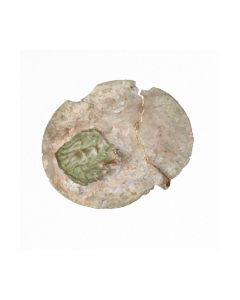 Ancient fibula from the Hattatt collection
Ancient fibula from the Hattatt collectionAncient fibula of the rare adlocutio type. Repoussé work of a scene from a Roman sestertius of Hadrian in celtic style. Find from Dorset in Roman Britain. Published in Hattatts famous book series on ancient fibulae.
Price: on request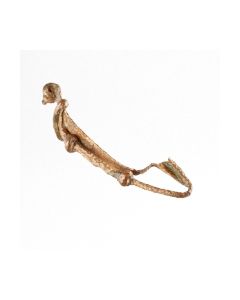 Celtic fibula from the famous Hattatt collection
Celtic fibula from the famous Hattatt collectionFibula from the La Tène II period. Found in Celtic Carnuntum. The piece is published in the standard work "Iron Age and Roman Brooches".
Price: on request Roman fibula in the shape of a rabbit
Roman fibula in the shape of a rabbitNice zoomorphic roman fibula made of bronze with enamel inlays depicting the young of the rabbit. Found near the Limes fortifications Pfoerring and Eining in Germany.
Price: on request Roman discus fibula with color glass paste
Roman discus fibula with color glass pasteSpannende Fibel mit Sterndekor und Glaspaste. Eine Weiterentwicklung keltischen Kunsthandwerks in der Zeit römischer Herrschaft. Gut dokumentierter Typ aus dem 2. Jh. v. Chr. mit Verbreitung in weiten Teilen Europas.
Price: on request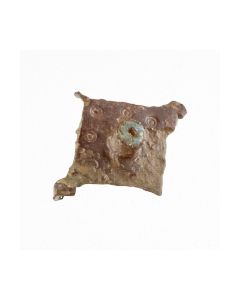 Roman fibula from the Richard Hattatt collection
Roman fibula from the Richard Hattatt collectionLozenge-shaped ancient roman fibula. The piece is published in the standard work "Iron Age and Roman Brooches". Found in Britain.
Price: on request Roman fibula from the Richard Hattatt collection
Roman fibula from the Richard Hattatt collectionLozenge-shaped ancient roman fibula. The piece is published in the standard work "Iron Age and Roman Brooches". Found in Norfolk, England.
Price: on request Large Visigoth bow brooch
Large Visigoth bow broochImpressive fibula of the Visigoths from the Migration Period. With five originally preserved glass inserts.
Price: on request Roman headstud brooch
Roman headstud broochInteresting fibula with a covered hinge mechanism and enamel decoration on the bow. From the 2nd century Roman Britain. Published in two stardard works on ancient brooches by Richard Hattatt.
Price: on request Roman knee brooch from Britannia
Roman knee brooch from BritanniaWell preserved example of this important fibula type that was introduced to Britain by Roman troop movements from the Rhineland. This specimen was already produced locally in Britannia province. It was published in two books on ancient fibulae.
Price: on request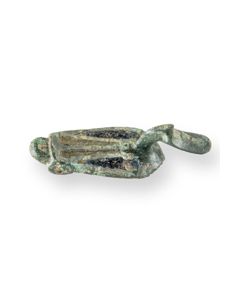 Bird brooch from Roman Britain
Bird brooch from Roman BritainNice fibula in the shape of a stylized water bird. A find from Britain and probably also a local Roman provincial production.
Price: on request Brooch from Roman Britain
Brooch from Roman BritainA rare mixture of cicada fibula and trumpet fibula, from the 2nd century. Found on the Isle of Wight.
Price: on request Dolphin brooch from Roman Britain
Dolphin brooch from Roman BritainThe so-called dolphin brooch is very British. This specimen was probably made by the Celtic Corieltauvi tribe, shortly after the arrival of the Romans in the middle of the 1st century. Published in two works by Richard Hattatt.
Price: on request Celtic penannular brooch
Celtic penannular broochPossibly made by the Celtic Durotriges tribe under Roman rule in Britain. The piece is published in two books by Richard Hattatt.
Price: on request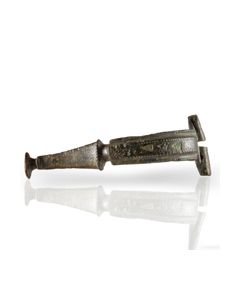 Roman Hod Hill brooch from the Hattatt collection
Roman Hod Hill brooch from the Hattatt collectionNice and rare enameled variant of the Hod Hill type. Found in Norfolk, UK. The piece is published in two books by Richard Hattatt.
Price: on request Brooch from Roman Britain
Brooch from Roman BritainThis rare variant of the T-shaped brooches was found in Lechlade, Gloucestershire. It dates to the 1st or 2nd century AR. From the famous Hattatt collection and published in two standard works for ancient fibulae.
Price: on request Roman rosette brooch from Colchester
Roman rosette brooch from ColchesterA nice brooch type from the 1st century with an especially well preserved decorative disc. From the famous Hattatt collection and published in two standard works on ancient brooches.
Price: on request Trumpet brooch with Celtic decorations
Trumpet brooch with Celtic decorationsUnusual and rare variant of high importance, published several times. Beautiful silver inlays on the bow showing tendrils in Celtic style. From the 1st century.
Price: on request Flying bird brooch from Roman Britain
Flying bird brooch from Roman BritainA local British production from the 2nd century. It is taking up a continental brooch type. From the famous Hattatt collection and published in two standard works on ancient brooches.
Price: on request

